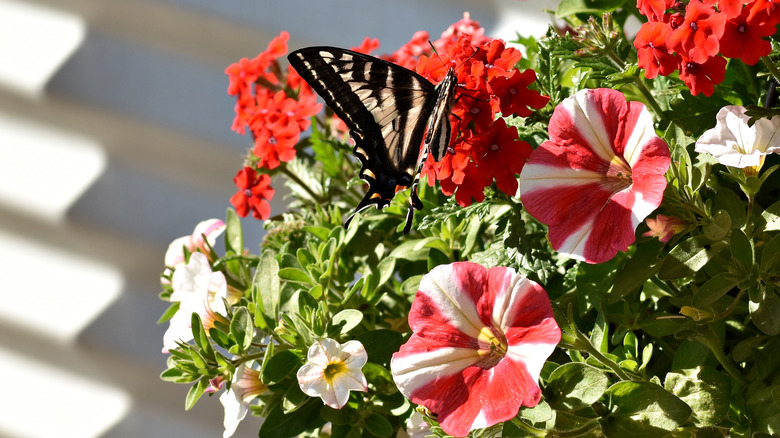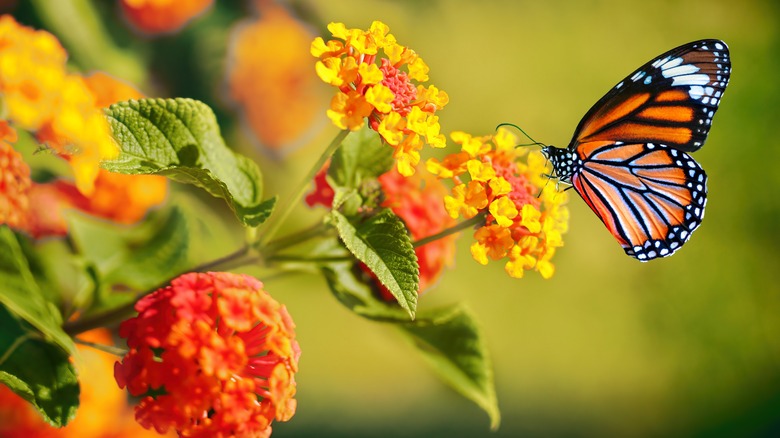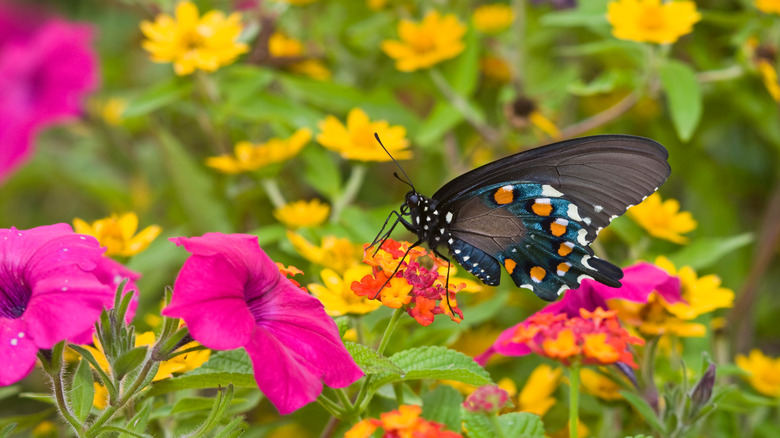Grow This Colorful Plant Near Your Petunias To Attract Beautiful Butterflies
Petunias (Petunia spp) are a fantastic addition to any flowerbed. They offer a long period of blooms with numerous color options, and don't require a lot of hands-on work to help them flourish. However, these plants benefit from having a strong pollinator attractor nearby to obtain those fabulous blooms at the highest level. The perfect choice for these plants is Lantana (Lantana camara), an easy-to-care-for plant that creates its own stunning blooms, which tend to last for numerous weeks with proper attention and the right environment. Lantana plants are also the perfect way to welcome butterflies, in particular, to your garden.
Petunias are one of the more common types of flowering annuals many gardeners purchase because of the versatility of their colors and ongoing blooms. Some will bloom at the start of spring and will continue to do well until the first frost. They also have an appealing scent that makes them a fantastic option for those looking for a fabulous display in their garden or in containers near the home. Some varieties even spread and can grow quickly with the support of pollinators. Though they need ample light throughout the growing season, they tend to grow very easily once in the right environment.
There are over 150 species of Lantana, and most of them have some common attributes, including their long flowering time. Easily grown in containers or in the garden itself, lantanas are a showy option perfect for attracting butterflies to your space, along with other pollinators.
The benefits of growing petunias and lantanas near each other
Petunias and lantana plants need similar environments to thrive and flourish with long blooming seasons. That starts with a sunny location. For the best results, plant them in full sun. Both can be planted in spring after the final frost of the year, with both preferring warm conditions to grow. As the weather warms in the spring, the number of blooms is likely to increase if the soil is kept moist but well-draining.
As companion plants, they also need the same basic soil conditions. Neither is too picky about the soil, but organic fertilizing is always beneficial to these plants. Lantana will thrive better when placed in slightly acidic soil, which can be supported by supplementing the current soil with a bit of acidic fertilizer.
One of the best reasons to plant these two together is that they will draw in pollinators, including butterflies. The bright colors and scents of these flowers help to draw in butterflies, and since they are likely to flourish throughout the season, you can expect them to attract throughout the year. Lantana is an excellent nectar source for butterflies. It can also be a host plant for caterpillars, which can be a fantastic way to watch butterflies develop over time. Lantana will attract a variety of butterflies, including monarchs, depending on where you live. Butterflies, in turn, are fantastic at helping to support petunia flowering.
How to encourage butterflies and flowers in your garden
Once you pick the specific varieties of petunias and lantanas you hope to grow, it's time to plant them in a way that encourages each plant to support the other. You can plant lantana in the late fall months, but both plants can go into your garden or containers in the spring after the final frost as well. Lantana typically needs about 4 feet of room to spread upwards and outward, creating a boxy-like shape. They work well as a low hedge that can border your flower garden within the bed. Be sure to water both plants well after first planting and keep the soil moist, but avoid pooling water to encourage the root system to grow.
Petunias are smaller flowering plants but still need about 12 to 18 inches of space for the best overall growth. Plant these near the lantana but in the direct sun — you don't want the height of the lantana to shadow the petunias.
As the plants start to establish and flower, it's a good idea to fertilize with an organic or balanced fertilizer. Water frequently. You can pinch the branches of petunias to encourage the plant to spread. You also need to consider deadheading larger plants to help them to continue blooming. Once in place, you'll likely see butterflies arrive as the blooms start to open. Pay close attention to caterpillars and other insects like bees in the area, too.


